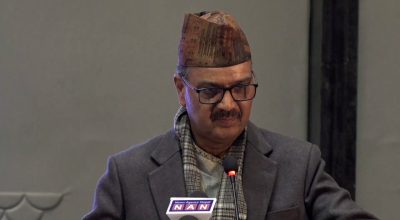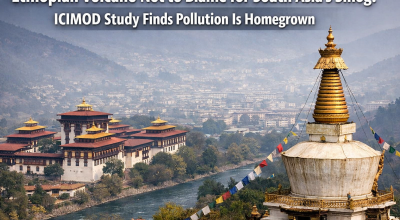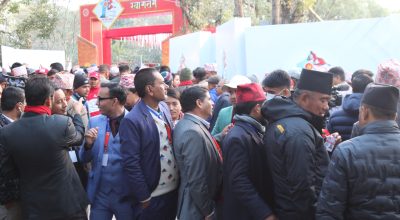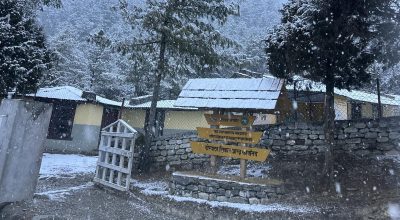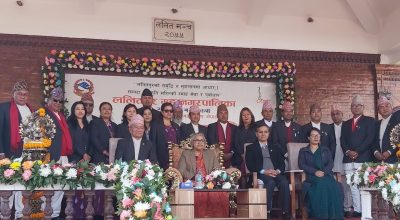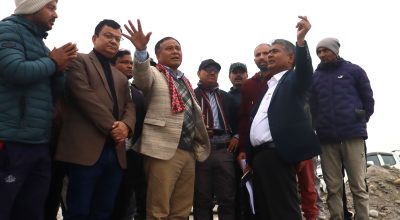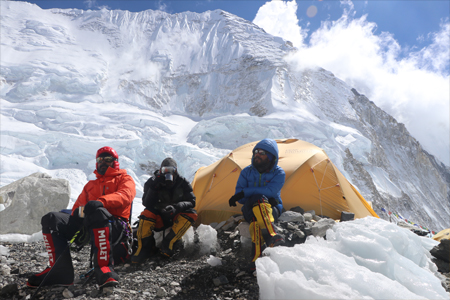
-Narayan Prasad Ghimire/RSS
KATHMANDU: With just two days left for commencement of the UN Climate Summit (COP26) at Glasgow, UK, the media have been reporting about the stories of sufferings from and concerns over climate change catastrophes in numerous countries. Going through the stories, one of the top concerns reported is the need of augmenting climate finance for the low-income countries.
The stories of mounting plight people have suffered with the extreme weather events as drought, cloudburst, heat waves, and blizzard are reported untiringly in media. The global climate community is presenting pressing climate issues and urging the developed countries to extend financial support they committed for the least developed countries (LDC), which are highly vulnerable to climate change.
Nepal, one among the least developed countries and marked as the fourth most vulnerable countries to climate change, also witnessed unexpected rainfall- the post-monsoon rains early last week. Caused by the collective effect of westerly and the wind from Bay of Bengal, the torrential rains caused huge loss of lives and properties. Province-1 recorded the maximum loss and damage followed by the far-west, Sudurpaschim Province.
The post-monsoon rains caused landslides, floods and inundation which badly affected 26 districts, leaving 117 people dead till October 24. Similarly, 32 persons were missing in the disaster. According to the Home Ministry, 118 houses were destroyed and 30 houses suffered partial damage. Media reported the loss of paddy crops to an estimated Rs 8 billion and road infrastructures loss worth Rs 1.5 billion.
However, detailed information about the loss and damage is awaited. Till October 24, Province-1 alone recorded the death of 67 persons while seven were stilling missing. Panchthar district alone suffered death of 30 persons in landslide and floods. Similarly, a total of 37 people lost lives and 22 went missing in Sudurpaschim Province. The post-monsoon rains causing such devastation have been linked to climate change catastrophe.
Moreover, at this write-up was being generated, southern belt of Italy, Sicily, was hit badly by the rains, killing at least two persons. The france24.com reports that a powerful cyclonic storm hit the southern Italian island of Sicily on Tuesday causing widespread flooding around the city of Catania, turning streets and squares into rivers and lakes and causing at least two deaths, as told by rescuers. The news has been credited to Reuters.
Such stories of climate catastrophes are reported abound throughout the year. As the world is plagued by the climate disaster, are the voices of developed countries, emerging developing countries and least developed countries same? Are they equally capable to cope up with this unavoidable tragedy- the tragedy invited mostly by the human activities? Of course they are not in equal capacity. Category of countries itself indicates that climate change is global but extent- the severity and intensity of effect are local.
For example, Nepal’s case itself is unique. Fragile topography, climate sensitivity and inadequate capacity to fight climate change have been argued as prominent reasons behind Nepal’s vulnerability to climate crisis, while the emerging economies are aspiring to further bolster their economy and the developed countries in comparison are equipped to minimize the risks they face by the climate catastrophe. The loss and damage therefore is high in the vulnerable countries like Nepal.
For adequate, predictable financing
With this in the background, how the LDCs become able and univocal in the COP26 to urge the developed and emerging economies to cut emission, as they are largely blamed for climate crisis bear significance. The voices raised so far however seem encouraging. Most of them have sought materialization of the commitment the developed countries made on climate finance. Nepal has stressed ‘adequate and predictable climate financing’ to cope up climate crisis.
A tweet drops. It is ours. It is by the Ministry of Forest and Environment. It reads: To combat and adapt to the changing climate, LDCs need adequate and predictable financing. Nepal urges that the climate finance commitments from developed parties should be met as soon as possible. It is stressed by climate change focal person at the Ministry, Radha Wagle, in the COP26 LDC pre-session at Glasgow.
Similarly, in an opinion article titled, ‘What is at stake for Bangladesh at COP26?’, Executive Director at Centre for Policy Dialogue in Bangladesh, Fahmida Khatun, writes vulnerable countries could invest more on reduction of climate change risks along with adaptation programmes. She said, “Unfortunately, the pledges made by the developed countries to mobilise USD 100 billion per year by 2020 remains unfulfilled.” She also underscored the need of new pledges by the developed countries for the vulnerable countries. “Experts and various climate action groups called for a minimum of USD 500 billion during 2020-24,” she reminded.
In an article to the World Economic Forum, a research associate at Stockholm Environment Institute, Georgia Savvidou, and a postdoctoral fellow at University of Maryland, Christopher Trisos, said, “Africa has contributed to emissions and climate change the least globally and receives the least financial support towards adaptation. Quantity and neglect of some sectors are just a couple of ways in which finance for adaptation to climate change in Africa falls short. Climate finance is a key area to be addressed at COP26.” They added that in case of inadequate financial assistance, the climate change is projected to push millions more of Africans into extreme poverty by 2030.
Furthermore, a news portal, afrik21.africa, talks about the climate march of Senegalese rural women ahead of beginning of COP26. It quotes President of the association Green Holidays, Khady Camara, as saying, “The Women’s Climate March also aims to promote the participation and consideration of the specific concerns of Senegalese and African women in the negotiations and conclusions of the COP26. The Women’s Climate March is above all a call to action for the respect of the commitments of Paris and the Western States in favour of the environment and the climate.”
The guardian.com brings a story of the Republic of Marshall Island. In the news, it quotes climate envoy for the Republic of the Marshall Islands, Tina Stege, “We are laser focused on the G20. They have the means to make a difference this decade. We all have a part to play, but there is no question that the key really rests with the G20.” Marshall Islands is the part of Micronesia.
LDCs urged for strong presence
In addition to the references from the LDCs and low-income countries, how other countries and UN agencies are taking the LDCs and climate change issues in light of COP26 carries relevance. The LDCs from the national and international forums have been urged to present their points strongly at COP26.
In a recent LDCs ministerial meeting held in the wake of IPCC report and imminent global event, UN’s top climate change official, Patricia Espinosa, said, “Nobody understands like you the gravity of our climate emergency. I encourage you to make your priorities as strong as possible and as ambitious as possible at this meeting.”
Patricia also talks squarely on the role of the big emitters. She maintained, “We particularly look to G20 nations, representing both developed and emerging economies, to lead by example. They are the main emitters responsible for 80 per cent of all global emissions and we cannot meet the 1.5-degree goal unless they pledge more decisive action — and do so rapidly.”
Time to change development model
It is time to see how the LDCs augment their climate diplomacy in the UN climate summit. Entire world is watching how the developed countries and emerging economic take the urgent issues pointed out by the LDCs. Whether the developed and emerging economies are ready to change their development model is the question of the day.
When asked about what Nepal can do at COP26, climate expert Manjeet Dhakal observed, “Nepal needs to inspire others to cut carbon emission.” He applauded Nepal’s recent Nationally Determined Contribution (NDC), saying it has prioritized clean energy transport.
In response to a question how Nepal, which is still not able enough to ensure basic facilities to its people, could take ahead the development activities along with climate resilience, he suggested, “Nepal can adopt new development model. It is not necessary to replicate the old western model of development which exhausted the nature like burning coal for energy.
Nepal can directly opt for green economy which does not cause climate change.” He argued that although developed countries are more responsible in terms of climate finance, cutting carbon is a shared responsibility. The process of climate finance is also lengthy, he argued.
Apathetic national politics
When such global event on urgent issues of climate crisis is being held, drawing world attention, our political parties seem so apathetic that none of them have spoken any word on it, leaving advocacy works to mere bureaucracy and CSOs.
Although a high level delegation led by Prime Minister Sher Bahadur Deuba is scheduled to attend and present Nepal’s status and show concern in the COP26, the political parties in the country are almost unaware about climate crisis. Undoubtedly, PM’s participation from Nepal gives a positive message to the world community. But, once our political parties which are indulged on political bickering had raised the issues of climate crisis, it would have given further solidarity and seriousness on the climate emergency.
Environmental expert Dr Ngamindra Dahal however focuses on bolstering institutional capacity in Nepal for effective dialogue and discussion. “Institutional and technical capacity is required to present issues in an organized and effective manner. But our institutional capacity is still weak,” he observed, stressing the need that dedicated team with expertise can do homework on avoiding climate disaster throughout the year in Nepal.
Build trust, ensure collaboration
Undoubtedly, the countries rich in human, technical, financial and natural resources can adopt adequate measures to minimize the effects/impacts of climate change. Similarly, the emerging economies try to make further progress with extensive use of their natural resources and adapt gradually. They may not intend to stay within the cap on use of fossil fuel as they naturally want to emerge bigger in power and economy. So, the major brunt is on poor countries with low-income, which have no option but to receive the financial and technical assistance, build capacity and adapt to the nature and ensure climate resilience.
So, the advocacy of the small countries with low income like Nepal must be stronger in the global event like COP26. In this connection, the government is learnt to focus on more than adaptation- the loss and damage reasoning the only adaption could not suffice to bear the brunt of climate change. The scale and intensity has intensified.
Importantly, whether the carbon emission is in Europe, America, Brazil, neighbouring countries or any other countries to mention few, it evidently contributes to the temperature rise in Nepal. So, it is not unwise for the countries like Nepal to expect bigger roles from them to cut emission with special initiatives. The loss and damage must be reiterated by the Nepali delegation there, also in the wake of the recent post-monsoon rains that caused landslides and floods in the country.
For the effective role from the high income countries, trust among them is must. The collaboration and trust building can ensure synergy to cope with the climate crisis. The atmosphere of distrust among the developed and developing countries gives negative message and mounts worries across globe.
On October 25, the Washington Post online edition published an interview it had with UN Secretary General, Antonio Guterres, where the UNSG expressed his worry over eroding trust. “There is a level of mistrust that is worrying. Mistrust between the large developed countries and the large emerging economies, and mistrust in general between the developed and developing world. Developed countries were not able up until now to implement, or even to present, a set of commitments that guarantee the implementation of the $100 billion in support to developing countries per year that [was promised] to start in 2020.”
Do the developed and large emerging economies pay heed to the views of the topmost diplomat of the world? Let’s see. The world is eagerly looking forward to COP26.






